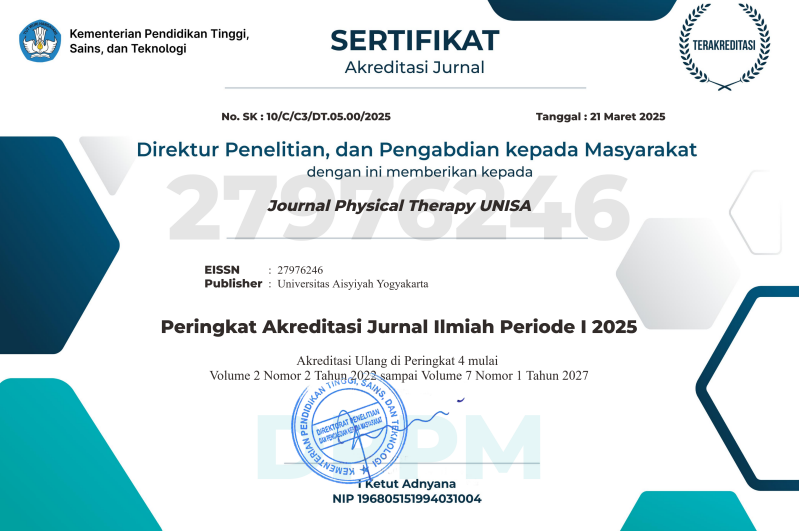Perbedaan pengaruh short foot exercise dan towel curl exercise terhadap keseimbangan dinamis pada remaja flat foot
DOI:
https://doi.org/10.31101/jitu.2656Abstract views 1338 times
Keywords:
short foot exercise, towel curl exercise, remaja, flat foot, Y balance testAbstract
Downloads
References
Abich, Y., Mihiret, T., Akalu, T. Y., Gashaw, M., & Janakiraman, B. (2020). Flatfoot and associated factors among Ethiopian school children aged 11 to 15 years: A school-based study. PLoS ONE, 15(8 August), 1–14. https://doi.org/10.1371/journal.pone.0238001
Abousayed, M. M., & Maxwell C. Alley, BA Rachel Shakked, MD Andrew J. Rosenbaum, M. (2017). Adult-Acquired Flatfoot Deformity Etiology, Diagnosis, and Management. Foot and Ankle Orthopaedics, 4(1), 1–11. https://doi.org/10.1177/2473011418820847
Abousayed, M. M., Tartaglione, J. P., Rosenbaum, A. J., & Dipreta, J. A. (2016). Classifications in Brief: Johnson and Strom Classification of Adult-acquired Flatfoot Deformity. Clinical Orthopaedics and Related Research, 474(2), 588–593. https://doi.org/10.1007/s11999-015-4581-6
Agustina, L. A. N. (2017). Hubungan Body Mass Indeks (BMI) Dan Bentuk Telapak Kaki Dengan Keseimbangan Dinamis Pada Lansia. Skripsi, 1–19.
Al Amin, M., & Juniati, D. (2017). Klasifikasi Kelompok Umur Manusia Berdasarkan Analisis Dimensi. Jurnal Ilmiah Matematika, 2(6), 1–10.
Alsuhaymi, A., Almohammadi, F., Alharbi, O., Alawfi, A., Olfat, M., Alhazmi, O., & Khoshhal, K. (2019). Flatfoot among school-age children in Almadinah Almunawwarah: Prevalence and risk factors. Journal of Musculoskeletal Surgery and Research, 3(2), 204. https://doi.org/10.4103/jmsr.jmsr_89_18
Amaliyah, M. N. (2016). Pengaruh Core Strenghthening Exercise Terhadap Keseimbangan Statis Anak Usia 5-6 Tahun. 2016.
Anniza, M., & Mayangsari, R. (2020). Hubungan Footprint Test Terhadap Q Angle pada Remaja Usia 12-15 Tahun di SMP Muhammadiyah 2 Gamping Yogyakarta. Jurnal VARIDIKA, 32(2), 103–115. https://doi.org/10.23917/varidika.v32i2.12147
Aulia, R. (2018). Hubungan indeks massa tubuh (imt) terhadap kaki flatfoot pada siswa-siswi sekolah dasar negeri 01 cibentang bogor. 1–14.
Banwell, H. A., Paris, M. E., Mackintosh, S., & Williams, C. M. (2018). Paediatric flexible flat foot: How are we measuring it and are we getting it right? A systematic review. Journal of Foot and Ankle Research, 11(1), 1–13. https://doi.org/10.1186/s13047-018-0264-3
Batubara, J. R. (2016). Adolescent Development (Perkembangan Remaja). Sari Pediatri, 12(1), 21. https://doi.org/10.14238/sp12.1.2010.21-9
Boryczka-Trefler, A., Kalinowska, M., Szczerbik, E., StÄ™powska, J., Åukaszewska, A., & Syczewska, M. (2021). How to Define Pediatric Flatfoot: Comparison of 2 Methods: Foot Posture in Static and Dynamic Conditions in Children 5 to 9 Years Old. Foot and Ankle Specialist, XX(X), 1–7. https://doi.org/10.1177/1938640021991345
Cahyaningrum, H. (2016). Perbedaan Gait Parameter Pada Kondisi Flexible Flat foot Dan Arkus Kaki Normal Anak Usia 11-13 Tahun Di Sd Negeri 3 Cepu. Thesis. http://eprints.ums.ac.id/42130/12/2. NASKAH PUBLIKASI.pdf
Dabholkar, T., & Agarwal, A. (2020). Quality of Life in Adult Population with Flat Feet. International Journal of Health Sciences and Research, 10(2), 193–200. www.ijhsr.org
Ezema, C. I., Abaraogu, U. O., & Okafor, G. O. (2014). Flat foot and associated factors among primary school children: A cross-sectional study. Hong Kong Physiotherapy Journal, 32(1), 13–20. https://doi.org/10.1016/j.hkpj.2013.05.001
Fajar, D., & Permana, W. (2013). Perkembangan Keseimbangan pada Anak Usia 7 s/d 12 Tahun Ditinjau dari Jenis Kelamin. Perkembangan Keseimbangan Pada Anak Usia 7 s/d 12 Tahun Ditinjau Dari Jenis Kelamin, 3(1), 1–5. https://doi.org/10.15294/miki.v3i1.2657
Fratti Neves, L., De Souza, C. Q., Stoffel, M., & Martins Picasso, C. L. (2017). The Y Balance Test – How and Why to Do it? International Physical Medicine & Rehabilitation Journal, 2(4), 1–3. https://doi.org/10.15406/ipmrj.2017.02.00058
Gonell, A. C., Romero, J. A. P., & Soler, L. M. (2015). Relationship Between the Y Balance Test Scores and Soft Tissue Injury Incidence in a Soccer Team. International Journal of Sports Physical Therapy, 10(7), 955–966. http://www.ncbi.nlm.nih.gov/pubmed/26673848%0Ahttp://www.pubmedcentral.nih.gov/articlerender.fcgi?artid=PMC4675196
Greenberg, E. T., Barle, M., Glassmann, E., & Jung, M.-K. (2019). Interrater and Test-Retest Reliability of the Y Balance Test in Healthy, Early Adolescent Female Athletes. International Journal of Sports Physical Therapy, 14(2), 204–213. https://doi.org/10.26603/ijspt20190204
Gupta, H., Yangdon, T., Gupta, U., & Kumari, T. (2016). Normative Data of Dynamic Balance of Lower Extremities Using Y-Balance Test in Cricketers with 16-25 Years of Age. IOSR Journal of Sports and Physical Education (IOSR-JSPE, 3(5), 1–6. https://doi.org/10.9790/6737-03050106
Habut, M. Y., Nurmawan, I. P. S., & Wiryanthini, I. A. D. (2016a). Hubungan Indeks Massa Tubuh Dan Aktivitas Fisik Terhadap Keseimbangan Dinamis Pada Mahasiswa Fakultas Kedokteran Universitas Udayana 1. 1–11.
Habut, M. Y., Nurmawan, I. P. S., & Wiryanthini, I. A. D. (2016b). Hubungan Indeks Massa Tubuh dan Aktivitas Fisik terhadap Kesimbangan Dinamis pada Mahasiswa Fakultas Kedokteran Universitas Udayana. Erepo Unud, 831, 1–14. https://simdos.unud.ac.id/uploads/file_penelitian_1_dir/599c69fad6ecfc2a1a488b9fb8ccbd00.pdf
Handayani, N. A. (2018). Pengaruh fartlek training terhadap vo2max pada mahasiswa over weight. 1–11.
Hoang, N. T. T., Chen, S., & Chou, L. W. (2021). The impact of foot orthoses and exercises on pain and navicular drop for adult flatfoot: A network meta-analysis. International Journal of Environmental Research and Public Health, 18(15), 1–17. https://doi.org/10.3390/ijerph18158063
Indardi, N. (2015). Latihan Fleksi Telapak Kaki Tanpa Kinesio Taping Dan Mengunakan Kinesio Taping Terhadap Keseimbangan Pada Fleksibel Flat foot. Journal of Physical Education Health and Sport, 2(2), 89–93.
Kasai, T., Kamada, H., Tomaru, Y., Tsukagoshi, Y., Nishino, T., Yamazaki, M., Miyakawa, S., & Shiraki, H. (2020). Longitudinal changes in musculoskeletal findings of elementary and junior high school students: a 1-year prospective study. The Journal of Physical Fitness and Sports Medicine, 9(2), 53–64. https://doi.org/10.7600/jpfsm.9.53
Kelly, L. A., Cresswell, A. G., Racinais, S., Whiteley, R., & Lichtwark, G. (2014). Intrinsic foot muscles have the capacity to control deformation of the longitudinal arch. Journal of the Royal Society Interface, 11(93). https://doi.org/10.1098/rsif.2013.1188
Kim, E. K., & Kim, J. S. (2016). The effects of short foot exercise s and arch support insoles on improvement in the medial longitudinal arch and dynamic balance of flexible flatfoot patients. Journal of Physical Therapy Science, 28(11), 3136–3139. https://doi.org/10.1589/jpts.28.3136
Lee, C. R., Kim, M. K., & Cho, M. S. (2012). The Relationship between balance and foot pressure in fatigue of the plantar intrinsic foot muscles of adults with flexible flatfoot. Journal of Physical Therapy Science, 24(8), 699–701. https://doi.org/10.1589/jpts.24.699
Listyorini, Shanti, M., & Prabowo, T. (2015). Effectiveness in Dynamic Balance: a Comparison between Foot Muscle Strengthening Using Elastic Band and without Elastic Band in Children Aged 8–12 with Flexible Flatfeet. International Journal of Integrated Health Sciences, 3(1), 26–32. https://doi.org/10.15850/ijihs.v3n1.404
Longo, U. G., Papalia, R., De Salvatore, S., Ruzzini, L., Candela, V., Piergentili, I., Oggiano, L., Costici, P. F., & Denaro, V. (2022). Trends in hospitalization for paediatric flatfoot: an Italian nationwide study from 2001 to 2016. BMC Pediatrics, 22(1), 1–7. https://doi.org/10.1186/s12887-022-03145-0
Lynn, S. K., Padilla, R. A., & Tsang, K. K. W. (2012). Differences in static- and dynamic-balance task performance after 4 weeks of intrinsic-foot-muscle training: The short-foot exercise versus the towel-curl exercise. Journal of Sport Rehabilitation, 21(4), 327–333. https://doi.org/10.1123/jsr.21.4.327
McKeon, P. O., Hertel, J., Bramble, D., & Davis, I. (2015). The foot core system: A new paradigm for understanding intrinsic foot muscle function. British Journal of Sports Medicine, 49(5), 290. https://doi.org/10.1136/bjsports-2013-092690
Mien, V. A., Mayasari, W., & Chaidir, M. R. (2017). Gambaran Faktor Risiko Flat foot pada Anak Umur Enam sampai Sepuluh Tahun di Kecamatan Sukajadi. Jurnal Sistem Kesehatan, 3(2), 97–102. https://doi.org/10.24198/jsk.v3i2.15010
Moon, D. C., Kim, K., & Lee, S. K. (2014). Immediate effect of short-foot exercise on dynamic balance of subjects with excessively pronated feet. Journal of Physical Therapy Science, 26(1), 117–119. https://doi.org/10.1589/jpts.26.117
Moon, D., & Jung, J. (2021). Effect of incorporating short-foot exercises in the balance rehabilitation of flat foot: A randomized controlled trial. Healthcare (Switzerland), 9(10), 1–12. https://doi.org/10.3390/healthcare9101358
Nambiar, S., & Alagesan, J. (2017). Prevalence and incidence of flat foot among Middle East and Asian Population: An Overview. International Journal of Pharmaceutical Science and Health Care, August.
Nissa, V., Fadillah, M., Mayasari, W., & Chaidir, M. R. (2016). Gambaran Faktor Risiko Flat foot pada Anak Umur 6-10 Tahun di Kecamatan Sukajadi Overview of Flat foot Risk Factors in Children Aged Six to Ten in Sukajadi District. Jurnal Sistem Kesehatan, 3, 1–6.
Nurhardiyanty, Mas’ud, A. K., & Rini, I. (2020). Pengaruh Pemberian Towel Curl Exercise Terhadap Kelincahan Anak Flat foot Usia 7-9 Tahun Di Makassar. Jurnal Fisioterapi Dan Rehabilitasi (JFR), 4(2), 67–73.
Nurhayati, U. A. (2021). Narrative Review : Ultrasound Berpengaruh Dalam Menurunkan Nyeri
Obun, O. C., & Ibeabuchi, N. M. (2020). Prevalence of Flat foot among 6-15 Year Old Nigerian School Children Resident in Lagos. Journal of Anatomical Sciences ·, November, 152–158.
Okamura, K., Kanai, S., Oki, S., Tanaka, S., Hirata, N., Sakamura, Y., Idemoto, N., Wada, H., & Otsuka, A. (2017). Does the weakening of intrinsic foot muscles cause the decrease of medial longitudinal arch height? Journal of Physical Therapy Science, 29(6), 1001–1005. https://doi.org/10.1589/jpts.29.1001
Patel, M., Shah, P., Ravaliya, S., & Patel, M. (2021). Relationship of Anterior Knee Pain and Flat foot : A Cross-Sectional Study. 11(March), 1–8.
Pavone, V., Vescio, A., Di Silvestri, C. A., Andreacchio, A., Sessa, G., & Testa, G. (2018). Outcomes of the calcaneo-stop procedure for the treatment of juvenile flatfoot in young athletes. Journal of Children’s Orthopaedics, 12(6), 582–589. https://doi.org/10.1302/1863-2548.12.180032
Perdana, A. (2014). Perbedaan Latihan Wooble Board dan Latihan Core Stability Terhadap Peningkatan Keseimbangan Pada Mahasiswa Esa Unggul. Jurnal Fisioterapi, 14(2), 57–68.
R, A., Malar, A., J, H., & G, S. (2021). The cause and frequency of PES Planus (Flat foot) problems among young adults. Asian Journal of Medical Sciences, 12(7), 107–111. https://doi.org/10.3126/ajms.v12i7.35410
Ramanda, R., Akbar, Z., & Wirasti, R. A. M. K. (2019). Studi Kepustakaan Mengenai Landasan Teori Body Image Bagi Perkembangan Remaja. JURNAL EDUKASI: Jurnal Bimbingan Konseling, 5(2), 121. https://doi.org/10.22373/je.v5i2.5019
Risangdiptya, G., & Ambarwati, E. (2016). Perbedaan Antara Keseimbangan Tubuh Sebelum Dan Sesudah Senam Pilates Pada Wanita Usia Muda. Jurnal Kedokteran Diponegoro, 5(4), 911–916. http://ejournal-s1.undip.ac.id/index.php/medico ISSN Online : 2540-8844%0AGerry
S, W., Agus, A., & Bafirman, B. (2019). Pengaruh Latihan Berjalan Di Atas Balok Kayu Terhadap Keseimbangan Dinamis. Journal Of Sport Education (JOPE), 2(1), 34. https://doi.org/10.31258/jope.2.1.34-39
Sahabuddin, H. (2016). Hubungan Antara Flat footdengan Keseimbangan Dinamis Pada Murid Tk Sulawesi Kota Makassar. Science of Surverying and Mapping, 41, 1–83.
Schedler, S., Kiss, R., & Muehlbauer, T. (2019). Age and sex differences in human balance performance from 6-18 years of age: A systematic review and meta-analysis. PLoS ONE, 14(4), 1–28. https://doi.org/10.1371/journal.pone.0214434
Setyaningrahayu, F., Rahmanto, S., & Multazam, A. (2016). Hubungan Kejadian Flat foot Terhadap Keseimbangan Dinamis pada Pelajar di SMAN 3 Malang. Physiotherapy & Health Science, 83–89.
Srirahayuningsih, P. H. (2016). Pengaruh Pemberian Towel Curl Exercise Dinamis Pada Anak Flat foot : Narrative Review
Stiffler, M. R., Sanfilippo, J. L., Brooks, M. A., & Heiderscheit, B. C. (2015). Star excursion balance test performance varies by sport in healthy division i collegiate athletes. Journal of Orthopaedic and Sports Physical Therapy, 45(10), 772–780. https://doi.org/10.2519/jospt.2015.5777
Sumadewi, K. T. (2021). Comparison of pedal arch anatomy in first and second grade elementary school students in denpasar with flat foot and normal foot. Biomedical and Pharmacology Journal, 14(1), 485–490. https://doi.org/10.13005/bpj/2148
Supriyono, E. (2015). Aktifitas Fisik Keseimbangan Guna Mengurangiresiko Jatuh Pada Lansia. J u r n a l O l a h r a g a P r e s t a s I, 11, 1–11.
Tanjung, D. H. (2015). Pengaruh Disiplin Kerja Dan Motivasi Kerja Terhadap Prestasi Kerja Pegawai Pada Dinas Sosial Dan Tenaga Kerja Kota. Jurnal Ilmiah Manajemen Dan Bisnis, 15, 27–36. http://jurnal.umsu.ac.id
Turner, C., Gardiner, M. D., Midgley, A., & Stefanis, A. (2020). A guide to the management of paediatric pes planus. Australian Journal of General Practice, 49(5), 245–249. https://doi.org/10.31128/AJGP-09-19-5089
Wibowo, D. B., Haryadi, G. D., & Pratomo, A. W. (2019). Pengembangan Pemindai Dokumen Menjadi Pemindai Telapak Kaki Untuk Identifikasi Flat foot. Jurnal Rekayasa Mesin, 14(3), 104. https://doi.org/10.32497/jrm.v14i3.1639
Zahidah, A., & Handari, H. K. (2019). Pengaruh Short foot exercise Dan Kinesiotaping Terhadap Perubahan Arkus Longitudinal Medial Pada Kondisi Flat foot. 85–90.
Zaidah, L. (2019). Pengaruh Towel Curl Exercise Terhadap Peningkatan Keseimbangan Pada Anak Dengan Flat foot Usia 4-5 Tahun. Jurnal Ilmiah Fisioterapi, 2(02), 57–66.
Downloads
Additional Files
Published
How to Cite
Issue
Section
License
Copyright (c) 2022 Ummy A’isyah Nurhayati, Siti Khotimah, Puji Ratnawati

This work is licensed under a Creative Commons Attribution-ShareAlike 4.0 International License.









